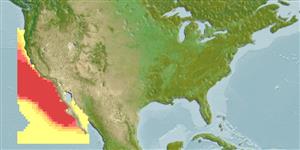Teleostei (teleosts) >
Argentiniformes (Marine smelts) >
Bathylagidae (Deep-sea smelts)
Etymology: Bathylagoides: Greek, bathys = deep + Greek, lagoides = similar to a hare (Ref. 45335).
Eponymy: Lars H Weseth (1895–1982) worked for the California Department of Fish and Game (1930– 1960) as captain of a number of research vessels including ‘Albacore’, from which the holotype was collected. [...] (Ref. 128868), visit book page.
Environment: milieu / climate zone / depth range / distribution range
Ecology
Marine; bathypelagic; depth range 25 - 1130 m (Ref. 96339). Deep-water; 45°N - 21°N, 126°W - 109°W
Eastern Pacific: California Current region from Oregon, USA to southern Baja California.
Size / Weight / Age
Maturity: Lm ? range ? - ? cm
Max length : 13.5 cm SL male/unsexed; (Ref. 96339)
Short description
Identification keys | Morphology | Morphometrics
Dorsal spines (total): 0; Dorsal soft rays (total): 10 - 14; Anal spines: 0; Anal soft rays: 13 - 17; Vertebrae: 43 - 47. Slender body, narrowed toward the end of caudal peduncle. Maximum depth slightly behind the pectoral fin base. Caudal peduncle short and narrow. Pectorals short, far from reaching origin of dorsal fin. Radial pattern of operculum present. Few gill rakers on the inner surface of epibranchial of first gill arch (Ref. 33679).
Oviparous, with planktonic eggs and larvae (Ref. 35604). Minimum depth from Ref. 58018.
Life cycle and mating behavior
Maturity | Reproduction | Spawning | Eggs | Fecundity | Larvae
Hubbs, C.L., W.I. Follett and L.J. Dempster, 1979. List of the fishes of California. Occasional Papers of the California Academy of Sciences, San Francisco, California, USA, No. 133, 51 p. (Ref. 7182)
IUCN Red List Status (Ref. 130435: Version 2024-1)
Threat to humans
Harmless
Human uses
Tools
Special reports
Download XML
Internet sources
Estimates based on models
Preferred temperature (Ref.
123201): 6.9 - 9.9, mean 7.9 °C (based on 15 cells).
Phylogenetic diversity index (Ref.
82804): PD
50 = 0.6250 [Uniqueness, from 0.5 = low to 2.0 = high].
Bayesian length-weight: a=0.00525 (0.00219 - 0.01260), b=3.01 (2.80 - 3.22), in cm total length, based on LWR estimates for this (Sub)family-body shape (Ref.
93245).
Trophic level (Ref.
69278): 3.3 ±0.4 se; based on size and trophs of closest relatives
Resilience (Ref.
120179): Medium, minimum population doubling time 1.4 - 4.4 years (Preliminary K or Fecundity.).
Fishing Vulnerability (Ref.
59153): Low vulnerability (10 of 100).
